
You wouldn’t expect to see a review of a backpack on a consumer electronics site, but this is no ordinary backpack. It has a trick up its sleeve. It’s more than meets the eye. It has the POWAH! You get the idea. The Powerbag Backpack is a backpack designed by fūl, maker of luggage and bags used by many, so you know build quality will probably be pretty solid. The thing that sets this bag apart is the built in battery charger. You can use the Powerbag Backpack to charge any device that can be charged by USB. There are a lot of factors that make or break an item like this, so read on to find out how it fares in our testing.
–~~~~~~~~~~~~–
Specifications
Interior dimensions of compartments in bag:
- Laptop – 18″ x 10.5″ x 1.5″
- Tablet – 8.5″ x 10″ x .5″
Exterior dimensions:
- 4.5″ x 13.5″ x 23″
- Weight: 3.1 lbs
Features
- Dedicated tablet compartment
- Holds up to a 16″ laptop
- Battery: 3000mAh Lithium Polymer, weight: 0.2 lbs
- Input: 12VDC, 1.2A
- Micro-USB, Mini-USB Output: 5VDC, 800mA combined
- Apple Connector Output: 5VDC, 1A
- USB Output: 5VDC, 1-2.1A
A Closer Look
At first glance, the Powerbag Backpack looks just like any other well built backpack.
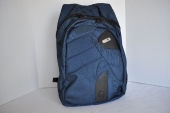 |
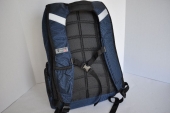 |
Upon closer inspection we can see where things stand out. On the side of the bag we have a water resistant charging port. This can be used to charge the removable battery while it’s still mounted in the bag. Right next to the charging port is the main charging compartment. This compartment has 3 different charging cords that can be used to charge 3 different devices at the same time. The wires routed through are a mini USB, micro USB, and proprietary iPhone connector. You simply drop your phone in the compartment and charge on the go. You wouldn’t want to use these connectors to charge a high power draw item like a tablet, as it would take too long. The standard USB port inside of the main compartment is for that.
 |
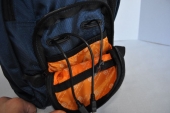 |
Inside of the front compartment is where the removable battery is stored. The standard model (which we are reviewing) comes with a 3000 mAh rechargeable battery, while the deluxe edition comes with a 6000 mAh battery. Below you can see a size comparison with the 3000 mAh battery and a quarter. The batteries are quite small and don’t add any noticeable weight to the backpack. The bottom of the battery also features a charge port identical to the one on the side of the bag. This way you can charge the battery while it is outside of the bag. I thought this was a nice touch that makes charging the battery much easier for the end user.
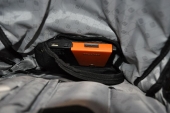 |
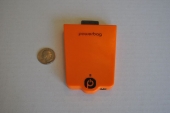 |
Concerns
While overall the design of the Powerbag Backpack is good, there are some design omissions that I feel would have made it even better.
No water bottle pouch – A side water bottle pouch is one of those things you don’t think about until you really need it. The left side of the bag (orientation when you’re wearing it) doesn’t have anything on it. It’s prime real estate for a water bottle holder. I know I would definitely have appreciated one while I was walking the show floor at CES. Instead I had to store my bottle in one of the main compartments. It made it a real hassle whenever I got thirsty.
 |
||
| Put a water bottle holder here |
Ruggedized bottom doesn’t extend up far enough – The bottom of the backpack features an impermeable, rugged piece of material to prevent the bottom from wearing out (a common problem in backpacks after years of use). My biggest complaint is that they should extend it up a couple of inches onto the sides of the bag. With the current design, there’s a possibility of the bag pooling water in the bottom if it’s accidentally set in a puddle. That’s not a good thing for a bag designed to house electronics. If aesthetics are a concern for having rubber come up and onto the sides, they could keep a design similar to what they have now on the bottom and just extend the material up inside of the bag, in between the padded liner. This way you still have an outward, aesthetically pleasing, fabric appearance, but the water protection of a ruggedized design.
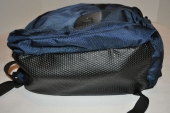 |
||
| Current design may allow pooling of water on the bottom |
Testing
For our testing we put the Powerbag through its paces by taking it to one of the largest trade shows in the world, CES. For journalists covering the event, it is a grueling week of hiking through the 2 million square feet of exhibition space at the Las Vegas Convention Center. On the show floor you find yourself constantly rooting through your bag to pull out business cards, store a press kit, or swap out a lens for your camera. As you can imagine a good bag, in addition to comfy shoes, is a must have for covering CES.
Carrying Capacity
On any given day during the show, the Powerbag held a netbook with charger, a HP Touchpad tablet with charger and Bluetooth keyboard, a Nikon D90 with lenses in a separate camera case (the camera case went inside of the Powerbag), a jacket, and enough press kits to choke a horse. On top of all this, there was still room for a 15″ laptop if I so desired. Carrying capacity was not an issue with the Powerbag. I was able to load myself down like a pack mule and not feel like I was going to rip a seam or split a zipper.
Comfort
I think it goes without saying that comfort is one of, if not the most important factor when selecting a backpack. This is something that will be strapped to your person for extended periods of time, you don’t want it digging into your shoulders or chaffing your skin.
The straps on the Powerbag are padded with a mesh liner. This will help air flow easier and allow better adhesion to your shirt, so the bag stays in place and doesn’t slip off your shoulders. The cross strap also helps keep the straps on your shoulders and helps alleviate some of the stress. One thing that was included, that I find missing in many other bags, is padding on the area that rests on your back. Many other backpacks that have laptop compartments don’t have this and it can get quite uncomfortable having a large, flat, rigid laptop pressed up against your back. The back padding helps with that a lot.
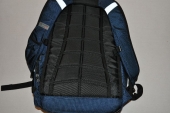 |
||
| Back padding really helps |
Electronics Performance
The electronics inside the Powerbag are what set it apart from your run of the mill JanSport school backpack. The standard battery is enough to charge most smart phones from zero battery to full 2 times. To put that in perspective, the included 3000 mAh battery will charge a tablet like the HP Touchpad or iPad 2 to about 50% charge.
Operation of the Powerbag is done by plugging in a device and then holding down the power button on the front of the bag. The same button can be briefly pressed to display the current battery level on the front of the bag. The Powerbag is intelligent enough to automatically switch itself off when it senses that there is no longer a load on the line. This prevents the bag from draining when not in use.
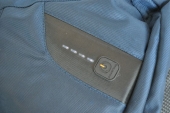 |
The time it takes to charge devices is comparable to what it would be if you plugged the device into a standard computer USB port. There are some exceptions where it will charge faster though. The iPad and others like it are able to draw the full 1A that it needs to charge at max speed, while some tablets like the Galaxy Tab and HP Touchpad are unable to charge at max speed. In the latter instance the devices may complain about insufficient current for charging, but they will still charge, albeit at a reduced speed. I talked to Powerbag while at CES and they told me that an adapter is in the works for these kind of devices, as the battery itself is able to output at 2.1A max.
Conclusion
The Powerbag Backpack was able to survive the week of CES with no problems. I can think of at least 3 separate instances where other journalists covering the show needed to use the bag to charge their devices while we were waiting for an event. That just shows you how useful something like this is. The price of the bag, at about $140, is quite reasonable considering what you’re getting. A replacement 3000 mAh battery will set you back about $40, while a 6000 mAh and 9000 mAh will set you back $50 and $60 respectively. The design of the bag is quite good (besides the omissions I mentioned) and it is comfortable, which is very important. If you do a lot of traveling or find yourself away from a charger longer than you would like, then the Powerbag Backpack would make a great addition to your travels.
Pros
- Large capacity
- Good routing of charging cables
- Comfortable
Cons
- No side water bottle holder
- Bottom may allow pooling of water inside the bag

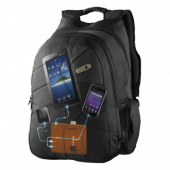

I want know the price of the bag and where came from? Thanks.